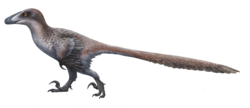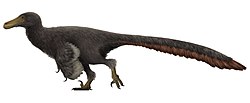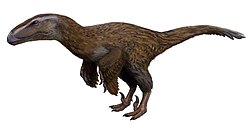
This timeline of dromaeosaurid research is a chronological listing of events in the history of paleontology focused on the dromaeosaurids, a group of sickle-clawed, bird-like theropod dinosaurs including animals like Velociraptor . Since the Native Americans of Montana used the sediments of the Cloverly Formation to produce pigments, they may have encountered remains of the dromaeosaurid Deinonychus hundreds of years before these fossils came to the attention of formally trained scientists. [1]
Contents
- Prescientific
- 19th century
- 1880s
- 20th century
- 1910s
- 1920s
- 1960s
- 1970s
- 1980s
- 1990s
- 21st century
- 2000s
- 2010s
- See also
- Footnotes
- References
- External links
In 1922 Matthew and Brown named the new genus and species Dromaeosaurus albertensis , considering it a new type within the family Deinodontidae, a now-defunct family name that once applied to the tyrannosaurs. Not long after, Velociraptor was discovered in Mongolia by the Central Asiatic Expedition. Dromaeosaur research was fairly quiet until the 1960s, when John Ostrom described the new genus and species Deinonychus antirrhopus . [2] This discovery played a major role in setting off the Dinosaur Renaissance because Deinonychus was obviously a vigorous, active animal, and exhibited characteristics linking it to the origin of birds. As such it brought support for controversial reinterpretations of dinosaurs as warm-blooded and ancestral to birds. [3] Its distinct nature and similarity to Dromaeosaurus led Ostrom to follow Edwin Colbert and Dale Russel's suggestion that the Dromaeosaurinae be regarded as its own family separate from the Deinodontidae. [4]
After Ostrom's initial research on Deinonychus, evidence continued to mount for a close evolutionary relationship between dromaeosaurids and birds. [5] The dromaeosaurid Sinornithosaurus milennii , described in 1999 by Xu, Wang, and Wu, is a notable example as the fine-grained Chinese limestone from which it was collected preserved its life covering of feathers. [2] Discoveries of feathered dromaeosaurids continued into the 2000s. Xu, Zhou, and Wang named the new genus Microraptor in 2000. [6] Three years later, Xu and others would report a new species in this genus that exhibited a bizarre "four winged" body plan with long pennaceous flight feathers on both its front and hind limbs. [7]




















